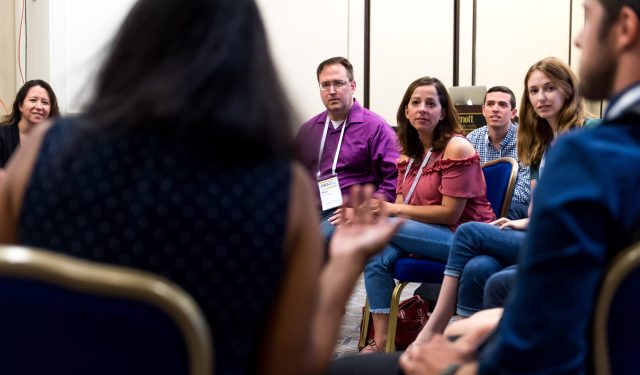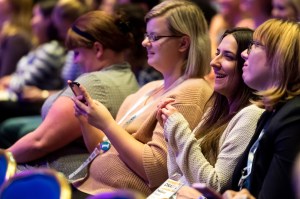ONA’s Suggestion Box, open Feb. 28 – March 29, is your opportunity to pitch session ideas and presenters for ONA18. This post, by ONA’s Head of Programs and Events, Trevor Knoblich, is the third in a series we hope will be useful references if you’re considering submitting a pitch.
Event designers are learning that most adults prefer a more interactive environment, rather than a passive one. Sometimes, attendees do want the opportunity to lean back and hear some big ideas. But on the whole, most people prefer a chance to create something, or share and reflect on their own experiences.
At ONA18, we’re aiming to ensure that most sessions are interactive, such as collaborating on a community document or participating in group discussions. In other words, we’ll have a variety of all session types, but less space will be dedicated to passive lectures or panels.
For inspiration, here are a variety of session formats, organized from more interactive to more passive, including samples from recent ONA events. Feel free to experiment; you may even have your own creative format in mind.
Session Format Ideas for ONA18
| Interactive | Active | Passive |
|---|---|---|
|
|
|
Collaborative document: There’s a sticky problem in the world; let’s put our expertise together and outline ideas to solve it. This format encourages participation from everyone in a group setting.
Example: ONA’s Table Talks
Facilitated discussion: Three to four topic experts facilitate small-group discussions around key issues related to your session topic. This format encourages people to ask questions and participate in a group conversation.
Example: Workshop for inclusive recruitment, hiring and retention
Workshop: Attendees complete an assignment, either individually or in small groups, to iterate on an idea. In this case, the session leader acts more as a facilitator, trying to focus attendees’ experience and expertise on solving a problem. The session allows people to reflect on their own experiences to generate best practices, or participate in games or activities that illustrate a concept.
Example: Everything you need to code you learned in kindergarten
Training: Participants focus on learning a technical skill. This format usually requires attendees to be physically doing something such as working on their laptops. In this case, the session lead is an expert walking people through specific tasks to learn a new skill or tool.
Examples: Learn how to build an Alexa skill; Do you have data stress? Solving challenges with sweet, sweet maps
Speed demos: Tall cocktail tables are pre-set with demonstrations of products, devices or tech tools. Participants are split into small, similarly-sized groups and distributed evenly around each table. Presenters have 5-7 minutes to demo their idea, then all attendees rotate, so that by the end of the session, attendees have visited each table once.
Town hall or ask-me-anything model: Experts host an open discussion on a challenging topic — with no prepared remarks beyond an introduction — and do their best to answer questions raised in the room. This format encourages most attendees to come armed with questions and be ready for discussion around their own experiences.
Examples: VR Technical Town Hall; Pitch session: How can I make my story go viral?
Masterclass: You’re an expert; you want to share best practices and answer questions. This format usually requires presenting for 20-25 minutes, and answering questions for the remainder of the session. In this format, a good number of attendees in the room will have the opportunity to ask questions.
Example: Expert interview advice with David A. Fahrenthold
Bold idea: While traditionally called a lecture, we prefer to think of it as a bold or provocative idea, as this gets to the heart of the format. You want to put your idea into the room and see how people react. Your idea should be fresh and well-researched, and most of the presentation should be spent on your conclusions, rather than how you arrived at them. In this format, roughly half of the session time should be dedicated to Q&A.
Example: A data state of the union: Can we make quality pay online?
Lightning Talks: You’ve got a group of people with sharp ideas, and you want to show off their ideas in rapid succession. These talks can either be in a freestyle format with a time limit, or “Ignite-style” in which speakers present 20 slides within a fixed time. The format allows time for a question or two between presentations.
Example: Lady leadership lightning talks
Debate: You and a colleague stake out an intellectual position and talk about its merits (e.g. all news organizations should be non-profit entities). Like the Bold Idea above, the conversation should be provocative and quickly get to the point. This format will leave plenty of time at the end of the session for questions.
We don’t have any examples! Be the first to pitch a debate! Journalists, it’s OK to have an opinion!
Panel: You want to explore a complex idea, and tap a variety of voices to share unique perspectives. You have a strong moderator to help keep to time and challenge presenters with difficult questions. This format usually requires presenting for about 25 minutes, leaving plenty of time for questions. And not every panelist needs to answer every question.
Example: The art of getting sh*t done; The legal panel
Feeling ready to pitch? Mark your calendar for Feb. 28, when we will open the Suggestion Box. Our previous post in this series covered 10 factors that make for a great pitch. The next post covered themes to consider when pitching to ONA18.
Refer to our Opportunities page if you’re interested in other ways to get involved or volunteer with the conference. For news and updates, follow us on Twitter @ONAConf or subscribe to our newsletter.



